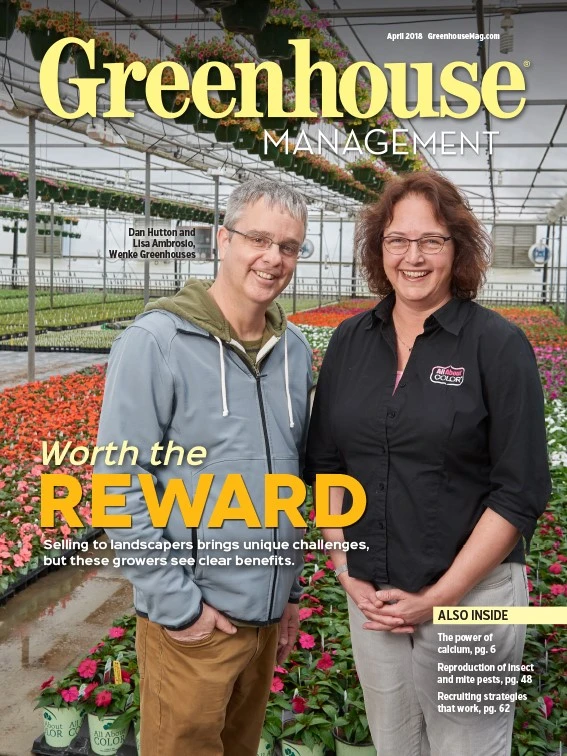

Landscapers depend on growers to provide the plant materials to bring their two-dimensional designs to life, and greenhouses benefit from selling bulk orders to commercial clients throughout the season. But, there’s always room for improvement in grower/landscaper relationships.
Landscapers shared these eight strategies for creating seamless relationships with growers.
Share a list.
When Eric Zacaroff works up a new landscape design, he starts with availability lists from his favorite greenhouses, noting, “I’ll often design an entire job based around what plants a vendor has in stock.”
Most of the larger growers provide updated lists each month, sending them via email or providing logins to secure web portals. Without an accurate list, Zacaroff, a landscape designer for Makeover My Yard in Harrisburg, North Carolina, must call multiple greenhouses to see whether the annuals and perennials he plans to include in residential designs are in stock. The extra time investment makes him more apt to skip sourcing from growers that don’t maintain availability lists for landscapers.
“I know it’s more work for growers to keep updated lists, but it can be the difference between a landscaper choosing one vendor over another,” Zacaroff says.
Offer options.

Sometimes the specific plants required for a landscape design aren’t available. Rather than getting a “not in stock” notice on an order, Dave Marciniak, landscape designer and founder of Revolutionary Gardens in Culpeper, Virginia, relies on growers to offer alternatives. He’ll often change a design or sell a client on an alternative when growers point out similar varieties that are in stock.
“Being offered an alternative is still easier than having to track down plants from multiple sources and coordinate multiple deliveries,” he says.
Susie Dempster, the owner of Blooming Designs in Norton, Ohio, says that growers must always advise landscaper customers of substitutions before sending alternate selections so there are no surprises when the truck is unloaded on the jobsite.
Streamline the ordering process.
Whether greenhouses offer online ordering or accept orders via fax or phone, the process should be as simple as possible. Zacaroff likes working with larger growers that have secure web portals where he can log in, see a list of plants with prices and order with a few clicks of the mouse.
Dempster often works with regional growers that accept orders via phone or fax; those that can expedite last minute orders are her go-tos for accommodating last-minute design changes. If Dempster emails an order to Graf Growers in Akron, Ohio, at 6:30 a.m., it’s picked and awaiting pickup just two hours later, allowing her crew to pick up plant material on their way to the jobsite.
Assign a sales representative.
Rather than talking to a different staff member each time she calls one of her favorite suppliers, for the past decade, Dempster has called the direct line of her dedicated sales rep. “She knows what’s important to me in terms of size and appearance,” Dempster says. “Our long-term relationship has saved me a lot of time.”
Not long after Marciniak planted trees on a commercial project, the client called to tell him that several died. Marciniak called the dedicated sales representative at one of his go-to growers to report the issue and the trees were replaced, no questions asked.
“Had I called and talked to whatever random person who answered the phone, it would have been a much more arduous process to do right by the customer,” he says.
Foster a team mentality.

Some of the sales reps Marciniak works with schedule lunch meetings to talk about new projects he has in the pipeline and offer suggestions for new varieties that could work well in the designs — and going the extra mile fosters positive grower/landscaper relationships.
John Puryear relies on grower relationships to learn about “hip new varieties” of annuals that he can incorporate into residential and commercial projects.
“It’s great to see growers be proactive about educating customers,” explains Puryear, the founder of Puryear Farms in Gallatin, Tennessee.
Growers that provide updates on new varieties, pass along information about possible issues with tried-and-true varieties (like an uptick in impatiens downy mildew), or share relevant links to articles from the local extension office help landscapers manage risk and better serve clients. A simple email or pre-season visit would do the trick, Puryear says.
Offer deliveries.
When she is seeking out smaller quantities of unusual plants, Susan Calhoun shops local greenhouses, tagging plants for pickup. But she depends on bigger companies like Monrovia, Blooming Nursery, Fisher Farms and Youngblood to provide the staple plants featured in the residential designs she creates for her Bainbridge Island, Washington landscaping firm, Plantswoman Design. Calhoun, the president and principal designer, often orders plant material at the start of the season and keeps it in stock. The sheer volume makes deliveries essential, she says, explaining that it’s too much for her to have to go out to a greenhouse to shop it.
For larger jobs, Marciniak also likes to have plants delivered, but some of the smaller greenhouses he works with don’t offer the service, so he sends a crew out to pick up plants. A simple solution, he believes, could be smaller growers working together with one truck picking up plants from multiple greenhouses and delivering to a landscaper’s jobsite for a flat fee.
Prioritize pickups.
When he has smaller jobs that require fewer plants, Zacaroff knows he can’t depend on deliveries. However, the volume of projects he juggles for Makeover My Yard means his busy crew cannot afford to wait for long periods of time for a plant order to be ready to load onto their trucks.
“I’ll place an order and the grower will pull it and pile it but [there have been times when] we’ve waited an hour or more to get [it] loaded,” he says. “All of the landscapers pull in between [8 and 11 a.m.] so there are lines of trucks [waiting]. It’d be helpful to have more staff devoted to making those mornings run smoothly.”
Keep up with the trends.

Five years ago, a mere five percent of the projects Marciniak designed and installed featured native plants. Today, the number has jumped to 30 percent — and he depends on growers to supply the plant material customers are requesting.
“It used to be a lot more difficult to get good-looking native plants,” he recalls. “Now natives are trending and growers are getting much better about having them available, which makes my job much easier.”
As mentioned earlier, Puryear is eager to learn about the latest annuals that he can incorporate into residential and commercial projects.
“We want to educate our customers about new varieties so we can get those in the contracts for next season,” he explains. “Our goal is to be innovative, and knowing what’s new and exciting helps with that.”

Explore the April 2018 Issue
Check out more from this issue and find your next story to read.
Latest from Greenhouse Management
- Anthura acquires Bromelia assets from Corn. Bak in Netherlands
- Top 10 stories for National Poinsettia Day
- Langendoen Mechanical hosts open house to showcase new greenhouse build
- Conor Foy joins EHR's national sales team
- Pantone announces its 2026 Color of the Year
- Syngenta granted federal registration for Trefinti nematicide/fungicide in ornamental market
- A legacy of influence
- HILA 2025 video highlights: John Gaydos of Proven Winners





